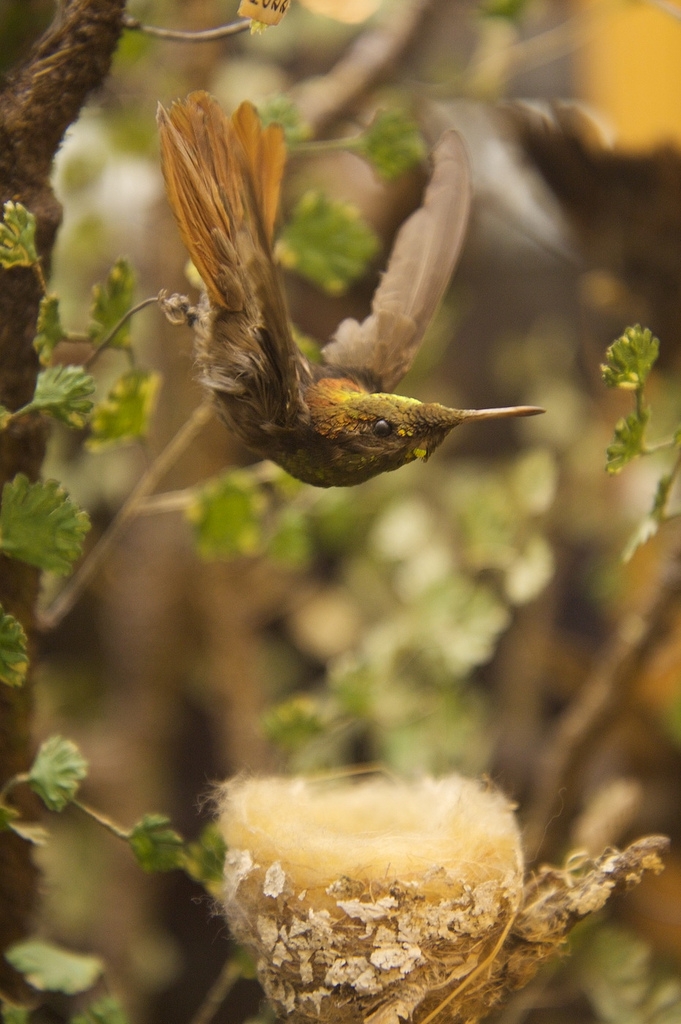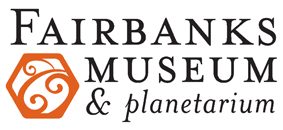
Collections
The Fairbanks Museum is part of a late nineteenth century trend to create and expand natural history museums.
The original, encyclopedic collection of specimens and objects from around the world was assembled by Franklin Fairbanks in the tradition of the Kunstkammer, or Cabinet of Curiosities, which he assembled in his home in St. Johnsbury, Vermont. Today, the collections in the Fairbanks Museum encompass zoology, paleontology, geology, anthropology, ethnology, and other natural sciences.
Franklin Fairbanks had a deep appreciation for natural history, and he wanted to share his love of the natural world with his community. Through his initiative and generosity, his collections and objects that were added over the years are curated and displayed in our expansive main gallery and balcony alcoves. The classic Richardsonian Romanesque building, which is listed on the National Register of Historic Places is the cornerstone of St. Johnsbury’s Historic Main Street District. With its fine wood interior, original display cases and dioramas, it is one of North America’s few surviving natural history museums where you are fully immersed in esthetic of the Victorian era.
The full-habitat dioramas created in the late 19th century by local taxidermist William Everard Balch, are rich in detail and rival anything from that period. Mentored by C.W. Graham of St. Johnsbury, he brings whimsical representations to his habitat renditions, grouping several generations and juxtaposing different seasons so viewers can glimpse into a hidden world.
Our collection of specimens and objects are the finest representatives of the Fairbanks legacy, natural history during the Victorian era, and the special qualities and history of the Northeast Kingdom of Vermont. Our goal is to continue to inspire, engage, and delight everyone who passes through the doors.
Natural History
The Fairbanks Museum balances the preservation of its rich Victorian legacy — seen in our natural history collections and the artifacts collected by its founder — while remaining strongly relevant to current issues pertaining to biodiversity and the natural world. The profusion of life-like bird trees and rich dioramas on display evoke the excitement of expeditions and of discovery. The original descriptive names of many specimens are still intact, providing an additional historical context to the taxonomic richness of the collection.
In addition to being visually exciting, our natural history collection is an important and irreplaceable record of biodiversity in various points in time. Some of the species represented in the collection are endemic and therefore only found in particular regions and nowhere else. Many are now threatened or endangered due to habitat loss or destruction. Some, like the Passenger Pigeon, are extinct. Significant collections include Philippine birds acquired from the reknown collector J.B Steere, which he collected during an expedition in 1887-88. Our collections include taxidermy mounts, fluid-preserved specimens, skins, bones, and fossils. Our invertebrate collections include insects, mollusks, corals, and sponges.
Our holdings also represent the diversity of Vermont’s flora and fauna, including boreal species whose southernmost limits are in Vermont. The herbarium contains a vast number of Vermont specimens collected in the 1890s by Dr. Ferdinand Blanchard of Peacham, as well as a comprehensive sample of New England herbaceous flora.
Archives
The Fairbanks Museum’s Archives houses materials that document the history of St. Johnsbury, the Northeast Kingdom region, and, to a lesser degree, the state of Vermont. Collection strengths include photographic materials, personal papers, and institutional records.
Archival collections are permanently valuable documents in various forms. They can be non-current records of an institution or organization, or the personal papers of an individual or a family, preserved because of their continuing value.
The Archives collections are available for research by appointment only. Museum staff do not do research for clients. To schedule an appointment with the Fairbanks Museum Archivist, please contact us.
Finding aids exist for all processed collections, and these are available upon request as as digital files or hard copy. Requests for appointments or finding aids should be directed to the Museum archivist.
Here is a sampling of categories and collections of archives accessible through the Fairbanks Museum and Planetarium:
Local life and business:

Carlton Feltch (undated photo)
Carlton Felch diaries, 1862-1918: Carlton Felch’s diaries document daily life in St. Johnsbury over a period of more than fifty years.
George Felch papers, 1880- 1937
Diarist George Felch documents daily life in St. Johnsbury from 1885-1937. A piano tuner and musician, Felch records his musical education at the New England Conservatory, his travels throughout Vermont’s Northeast Kingdom region tuning pianos, and his involvement in St. Johnsbury’s town band.
The Boys of Summerville School, 1881.
W. Henry Herrick diaries, 1861-1871
The collection consists of five bound diaries covering the years 1861-1871 with the years 1868-1869 missing. The diaries describe Herrick’s work as an employee of the E.T. & H.K. Fairbanks Company, where he eventually became the foreman of the scaling of weights section. The diaries describe Herrick’s service as a member of the band of the 3rd Regimental Vermont Volunteers. Herrick was the leader of the North Church choir and performed in the band and the diaries contain programs from musical performances.

View of St. Johnsbury from Harris Hill (1889)
Local history photograph collection, 1800’s-1900’s.
Comprised mostly of photographic prints depicting the buildings, landscapes, events, and inhabitants of St. Johnsbury, Vermont and surrounding towns.
Cased photograph collection, [ca. 1843-ca. 1880]
Includes daguerreotypes, ambrotypes, and some tintypes and unidentified processes. In addition to portraits, which comprise most of the collection, there are some images of buildings and objects. Many of the images depict the Fairbanks family and their relatives. Other families and individuals represented are the Clapp family, the Jewett family, the Spaulding family, Benjamin Badger, and George Knapp. Many individuals are unidentified, although most appear to be from the vicinity of St. Johnsbury, Vermont
Claire Dunne Johnson papers, 1800-1996
Comprised of local historian Claire Johnson’s research notes in various forms, collected documents and photographs, writings and articles, lectures and teaching tools, genealogies, and correspondence, these papers serves as an excellent first resource for any inquiry concerning St. Johnsbury.
 Gerald Heon papers, 1830-1999
Gerald Heon papers, 1830-1999
Comprised of photographs, postcards, newspaper clippings, ephemera, historical documents, videos, audio tapes, and self-published works and pamphlets collected by Gerald Heon in his efforts to document the history of St. Johnsbury.
Fairbanks family collection 1800’s -1900’s
Includes family documents of all types. An extensive photograph collection of individuals, families and homes, genealogical materials and bound materials owned or compiled by family members.
E. and T. Fairbanks Co. collection, 1810-1985
Includes materials collected by the Fairbanks Museum relating to the E. and T. Fairbanks Co. and related businesses. These date back to the Fairbanks family’s mercantile business in the early 19th century and continue through the late 20th century, when the Fairbanks factory in St. Johnsbury had long ceased to be the center of operations for the scale manufacturing industry
Harriet Pope and Charles Walter Carpenter papers, 1895-1902
The collection is primarily comprised of letters exchanged by Harriet Pope and Charles Walter Carpenter during the period of their courtship. Hattie served as domestic help for St. Johnsbury families and Charles Walter worked as a machinist in Claremont, NH. Their letters contain occasional references to their working lives.
Agriculture
George C. Cary papers, 1898-1986
George Clinton Cary (1864-1931), a prominent St. Johnsbury businessman also was a hobbyist farmer, raising cattle and Welsh ponies. His papers include a scrapbook documenting these activities.

Fairbanks Museum under construction (1891).
Institutional
Fairbanks Museum and Planetarium records, 1891- ongoing
Comprised of records documenting all aspects of the museum’s history and activities since its inception in 1891. The archives reflect the museum’s commitment to interpreting the region’s natural and applied sciences and their extensive education programs.
The Northern New England Weather Center Records, 1894 – 1997, ongoing
Includes the observations and recordings compiled at the Fairbanks Museum’s Center, documenting meteorological conditions in St. Johnsbury and northern New England from 1894 to the present.

Early illustrated aerial map of St. Johnsbury, 1884.
Maps
Fairbanks Museum map collection, 1850-1972
Includes maps of St. Johnsbury, the Northeast Kingdom counties (Caledonia, Essex, and Orleans), Orange County, a handful of individual towns, and the states of Vermont and New Hampshire. A large collection of U.S. Geological Survey maps of Vermont and New Hampshire are also present.

William Scott the Sleeping Sentinel (undated)
Civil War
Civil War collection, 1861-ca. 1960
This collection is now housed in the St. Johnsbury History & Heritage Center.
Includes individual records documenting Vermont’s participation in the Civil War, with an emphasis on individuals and regiments from St. Johnsbury and the surrounding area. Also includes some records relating to the Chamberlain Post G.A.R. chapter.
Turrell E. Hariman papers, 1862- 1901
Includes letters, a memoir, and photographs documenting the military service of Turrell Harriman, of Peacham, VT., who enlisted in the Eighth Vermont Regiment at the age of fifteen.
Woman’s Relief Corps, Howard No. 24, Lunenburg, VT, records, 1886 -1961
Includes records documenting the activities and practices of the Lunenburg chapter of the Woman’s Relief Corps (the auxiliary to the Civil War veterans’ Grand Army of the Republic) and its parent national organization.

Siber: White Mountains, NH
Fine Arts
Helmut Siber Collection 1940-1997
The collection includes watercolor paintings of weather subjects, sketches of birds, animals and other subjects, photographic prints and negatives, diaries, field notes, pamphlets, journal and magazine articles, correspondence, biographical and teaching materials of Helmut Siber. Siber was well known for his paintings of clouds and weather phenomena.
Fairbanks Family Legacy
The Victorian passion for travel initiated a generation of cultural collectors eager to show off their treasures from faraway places. Friends and family of Franklin and Frances Fairbanks donated many of their souvenirs to our collections; other objects were brought back by missionaries and representatives of the Fairbanks Scales Company. These artifacts offer a glimpse into cultural diversity of destinations that would have been exotic to viewers from northern New England in the 19th century. These objects include tools, weapons, clothing and woven textiles, decorative arts, household items, toys and trade materials. Even archaeological artifacts were acquired from the American Northwest, Malaysia, the Philippines, Asia, the Middle East and Africa.
In recent years, we have reexamined these collections to establish how and where artifacts in this collection were acquired. In some cases, receipts from a purchase documents the transaction, and in other cases correspondence from a collector describes where the objects originated. The Fairbanks Museum is committed to ethical and respectful representation of any artifact in our collection.
Displays featuring some of these items can be found in our mezzanine alcoves.
